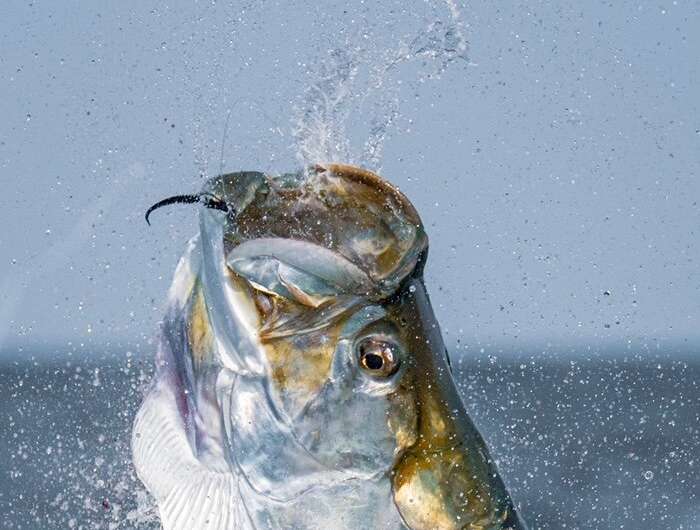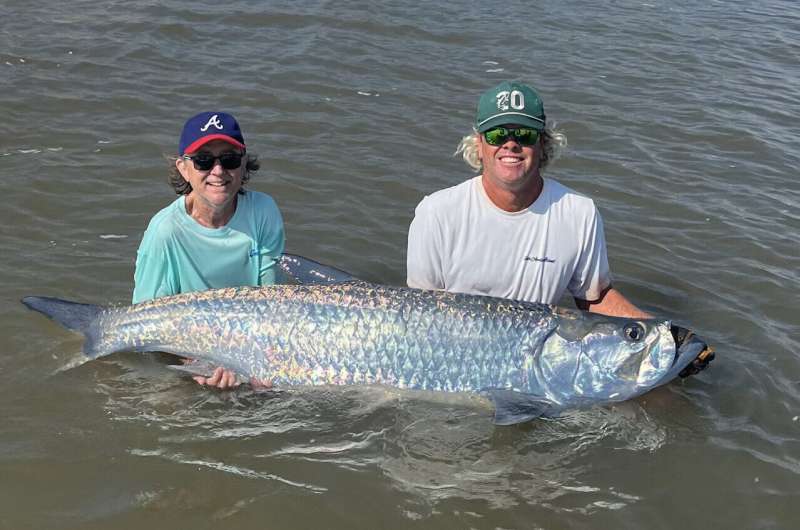This article has been reviewed according to Science X's editorial process and policies. Editors have highlighted the following attributes while ensuring the content's credibility:
fact-checked
peer-reviewed publication
trusted source
proofread
On the trail of the 'Silver King': Researchers reveal unprecedented look at tarpon migration

New research led by the University of Massachusetts and published recently in Marine Biology unveils a first-of-its-kind dataset, gathered over five years, that gives the finest-grained detail into the timing and spatial extent of tarpon migration. The work leveraged networks of thousands of acoustic receivers that tracked 200 tarpon over more than five years. One of the key findings is that there are two distinct subgroups of tarpon, which has immediate implications for efforts to conserve the fish, known to anglers as the "Silver King."
"Every fish tells a story," says Lucas Griffin, a postdoctoral researcher in environmental conservation at UMass Amherst and the paper's lead author. "And yet, up to now, we haven't known all that much about tarpon."
Tarpon are one of the most iconic salt-water fish in the Southeastern and Gulf states. Many an angler spends their life dreaming of hooking a 200-pound Silver King, fish which are known to fight fiercely, often leaping entirely clear of the water in their efforts to shake a hook. The tarpon fishery, which extends from Texas to the Carolinas in the U.S., is, by some estimates, a multi-million-dollar-per-year industry, and the fish is tied deeply to local culture.
Yet, despite the legendary toughness of the species, the tarpon is listed as "vulnerable" by the International Union for Conservation of Nature, and their populations seem to have been affected by fishing, degraded water quality and habitat loss. Because tarpon are a long-lived fish—they can live for 50 years or more—and because they migrate great distances, they are especially vulnerable to the various threats that they may encounter when migrating over the course of their long lives.
Indeed, as Griffin and senior author Andy Danylchuk, professor of fish conservation at UMass Amherst, showed in previous research, anglers and guides have reported a marked decrease in the tarpon fishery.
How, then, to track such a fish?
Part of the answer involves the high-tech world of acoustic telemetry, which involves two different devices: an acoustic receiver, anchored in place for years at a time, and a small acoustic transmitter, about the size of an AA battery, surgically implanted in tarpon. Every time a tagged fish swims within the detection range of a receiver, the receiver records the date, time and ID of that specific fish.
The transmitters can't be lost, they work continuously for at least five years and, because they're small, they don't potentially hinder the fish's movement, in the way that larger, external electronic tags, such as satellite tags, can. "There's really no other way to get such a detailed understanding of where and when tarpon are migrating, and over so many years," says Danylchuk, who, along with Griffin, previously demonstrated the power of acoustic telemetry networks.

But simple technological capability isn't enough. Tracking the Silver King takes teamwork. So Griffin and Danylchuk teamed up with the Bonefish & Tarpon Trust, other marine researchers and local fishing guides and anglers in the Southeastern U.S. and the Gulf of Mexico. They used collaborative networks of acoustic receivers that other scientists had set up to monitor various marine species, and to find enough fish to track, Griffin and Danylchuk worked closely with guides and anglers from the Florida panhandle to central South Carolina who would let them know when they landed a tarpon which could be fitted with a transmitter. And the pair took up hook and line themselves.
"Although tarpon are large and put up quite a fight, they are also fragile fish," says Griffin. "We had to worry about sharks, and when we did manage to hook a tarpon and bring it alongside the boat, we had to work very quickly and delicately to get the transmitter implanted."
"All hell breaks loose when you hook a tarpon," Danylchuk adds, "and they are very physically difficult to catch, which is why anglers love them." But the work paid off: the team tagged 200 fish, of which 109 were tracked over the course of years. Every time one of these fish swam past one of the thousands of deployed receivers it was recorded, yielding a database of over 500,000 detections.
"It's the most extensive database on tarpon movement to date," says Griffin, and it gave the researchers a number of hitherto unknown plot points in tarpon's story.
It turns out that there are actually two distinct sub-groups of tarpon. Though Griffin and Danylchuk have previously shown that many tarpon congregate around the Florida Keys in the spring to spawn, their new research shows that one group predominantly migrates up the Southeast coast, while a second group heads for the Gulf of Mexico. Nor are these migration paths random: "it was amazing to see that many individual tarpon used the same migration routes from year to year," says Griffin.
"What this tells us," he adds, "is that different groups of tarpon will encounter different threats." For instance, tarpon in the Gulf of Mexico are likely to encounter harmful algal blooms and cross into states where it is still legal to harvest tarpon as trophies, while in the mid-Atlantic tarpon may be more impacted by changes in freshwater flow and the overharvest of their prey.
"This tells us a number of things," says Danylchuk. "First of all, our conservation measures need to reflect the fact that many of these tarpon aggregate and likely spawn in the Florida Keys." But Danylchuk also points to the need for policies tailored to specific groups of tarpon. "Tarpon along the Atlantic coast have a different set of conservation priorities than those in the Gulf, but because many converge in the Keys, our science indicates that policies and management for tarpon needs to be regional, not state by state."
There is still more work to be done, and the team is currently working to understand how tarpon diet differs for the two migratory groups—research powered by this dataset. "The power of this technology," says Danylchuk, "is that we can use it to address so many questions critical to the application of the science to the real world."
More information: Lucas P. Griffin et al, Individual variation and repeatability of Atlantic tarpon Megalops atlanticus migrations in the southern US: implications for conservation and management, Marine Biology (2023). DOI: 10.1007/s00227-023-04311-3
Journal information: Marine Biology
Provided by University of Massachusetts Amherst




















